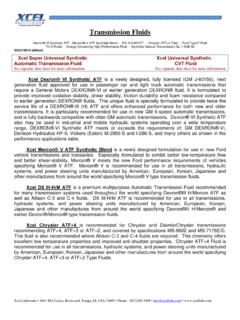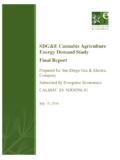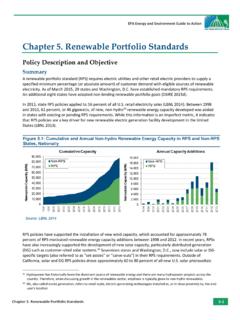Transcription of Central Minnesota Municipal Power Agency WPPI Energy Xcel ...
1 understanding easements and rights -of-WayDelivering electricity you can rely onCentral Minnesota Municipal Power AgencyDairyland Power CooperativeGreat River EnergyMinnesota PowerMinnkota Power CooperativeMissouri River Energy ServicesOtter Tail Power CompanyRochester Public UtilitiesSouthern Minnesota Municipal Power AgencyWPPI EnergyXcel EnergyHow are landowners paid for an easement?Landowners typically are given a one-time payment basedon fair market value for easement rights to their can elect to spread the payment out over time. For instance, landowners can choose to receiveinstallments with interest paid annually on the remainingbalance. Traditionally, the easement payment is based on a percentage of the appraised land value. Also, of course,the majority of land still is usable, particularly in agriculturalsettings where farmers can continue to use the land forraising crops or as also are eligible for reasonable compensationfor property damage that may occur when the transmissionline is constructed and in the future during repair and maintenance, as described in the easement document.
2 Who pays property taxes for the right-of-way on which the transmission line is constructed? The landowner continues to pay property taxes on the right-of-way, although some states, including Minnesota , mayprovide landowners a property tax credit in proportion to thelength of the transmission line that crosses their easement rights will be needed for the construction of a Power line?The CapX2020 projects will require easements that allowfor surveying, construction, operation and maintenance of a transmission line across a defined right-of-way located on the landowner s property. These easements will includethe right to clear, trim and remove vegetation and trees from within the right-of-way, as well as tall and dangerouslyleaning trees adjacent to the right-of-way that may threatenthe line if they is an easement?An easement is a permanent right authorizing a person orparty to use the land or property of another for a particularpurpose.
3 In this case, a utility acquires certain rights tobuild and maintain a transmission line. Landowners arepaid a fair price for the easement and can continue to usethe land for most purposes, although some restrictions areincluded in the agreement. The easement instrument is the legal document that must be signed by the landownerbefore the utility can proceed. What is a right-of-way?A right-of-way is the actual land area acquired for a specificpurpose, such as a transmission line or is the difference between an easement and a right-of-way?Simply put, an easement is a land right and a right-of-wayis the physical land area upon which the facilities (transmis-sion line, roadway, buildings, etc.) are located. How long does an easement last? easements are perpetual and are not subject to terminationor expiration. Once an easement is signed, it becomes part of the property record.
4 The utility, the landowner who signedthe easement and all future owners of the property are boundby the terms of the easement agreement. The utility can, at some point, choose to release the easement rights if itremoves the transmission line and abandons the people talk about building new transmission lines, they often refer to an easement or a right-of-way (ROW).Although the terms often are used inter-changeably, they are distinct concepts. What activities are allowed within the easement area?Land within the right-of-way may be used for any purposethat does not interfere with the construction, operation ormaintenance of the transmission line. In agricultural areas,the land may be used for crop production and pasture. In areas where the land will be developed, streets, lawnextensions, underground utilities, curbs and gutters, etc.
5 ,may cross the right-of-way with prior written permissionfrom the are there restrictions on the land?Providing electrical Energy is an essential public service,and some restrictions are necessary within the right-of-wayto maintain reliability. Utilities have determined that thebest way to prevent outages is to restrict the placement ofstructures within the right-of-way. If a building or structure in the right-of-way caught fire, it could burn into the powerline and take the line out of service for an extended , buildings or other structures in the right-of-waycan hamper maintenance crews from accessing the line ifan outage occurs. What are the main building and plant restrictions in the easement?Conditions will vary, but the primary building and plantingrestrictions within the right-of-way are in place to ensurethat a utility has the necessary clearance for operation and maintenance, and to comply with the NationalElectrical Safety Code.
6 Restrictions within the right-of-waystrip prohibit constructing buildings and structures, storingflammable materials and planting tall-growing trees. Why doesn t the utility just buy the land instead of negotiating an easement?Utilities main interest is in simply acquiring the rights to apiece of land in order to build and maintain a transmissionline. Owning the land is not required to do this. Landowners, for the most part, prefer to retain ownership ofthe property so they can maintain better control over its usewithin the easement restrictions. Often, retaining ownershipallows the landowner continued use of the property forthings such as agricultural operations, yard extensions oropen space, allowing the property to continue to contributepositively and productively to the owner and the adjacent uses pose no threat to the line and do notcreate a public hazard.
7 Generally, how large is the area covered by an easement or a right-of-way?The voltage and the type of transmission structure beingbuilt determine the size of the right-of-way. For 345-kVlines, the typical right-of-way is up to 150 feet wide. What happens when the landowner and utility cannot agree on the easement or payment?If an agreement cannot be reached, a utility may pursue astate-governed process called condemnation, under which a judge and a panel of impartial individuals decide whetherthe easement is needed and its value. The condemnationprocess varies from state to state. In general, states establish strict procedures for determining the amount alandowner should be paid by a utility for acquiring a rightfor construction and maintenance of a transmission line. Agovernment s right to acquire or authorize the acquisitionof private property for public use, with just compensationbeing given to the owner, is called eminent some states when a transmission line crosses a ruralproperty, a landowner, under certain conditions, may requestthat the utility purchase the entire property.
8 * This fact sheet is not a legal document. It is meant to provide general information about easements and rights -of-way. Individual state statutes differ and each utility has itsown process. 5-5-2009










